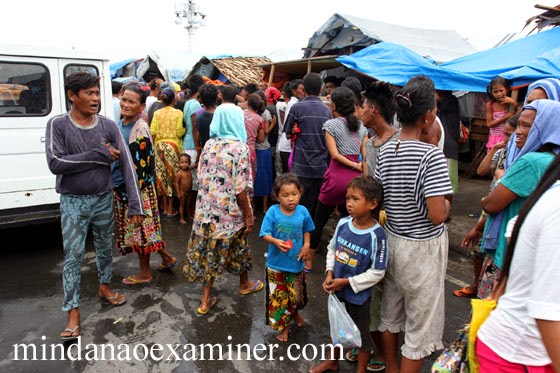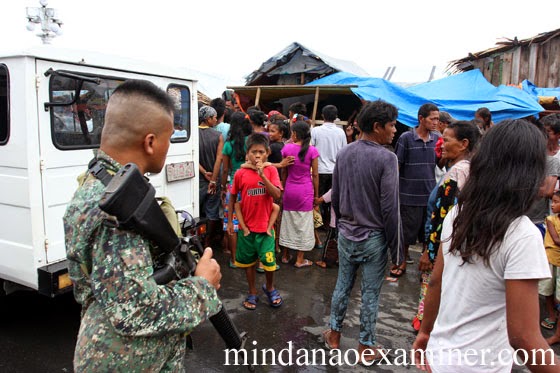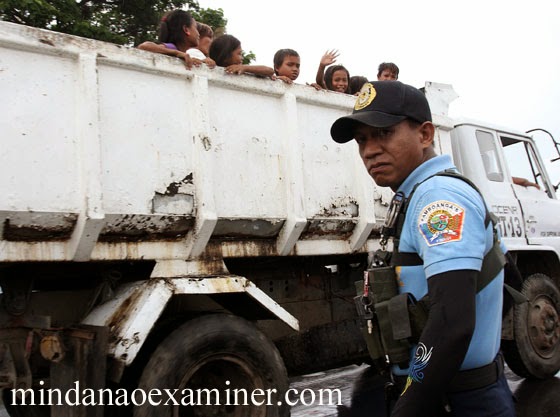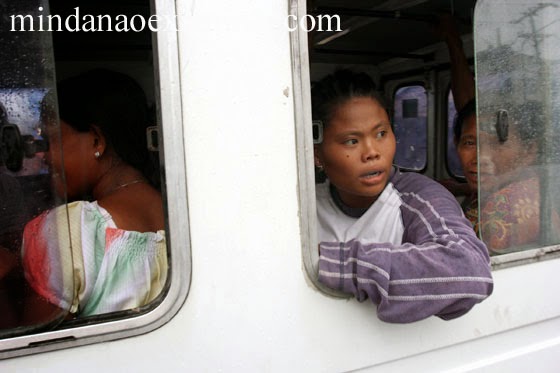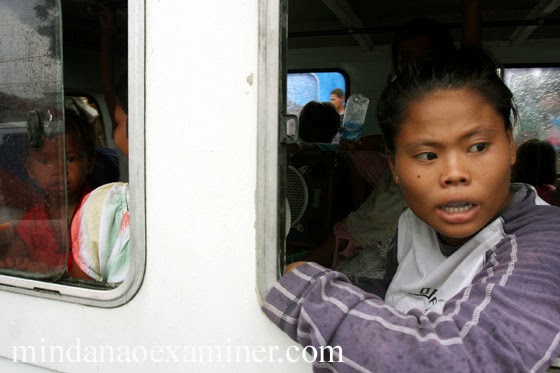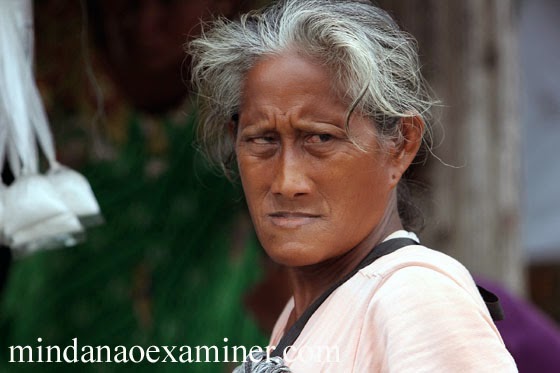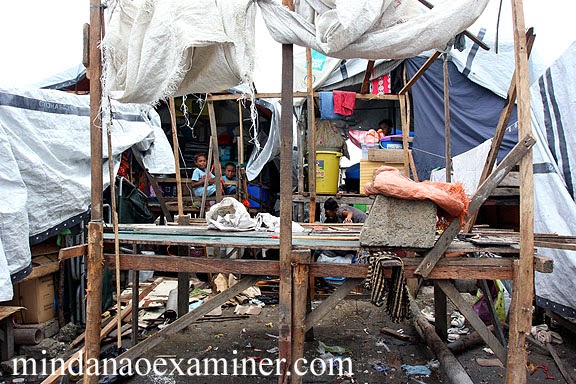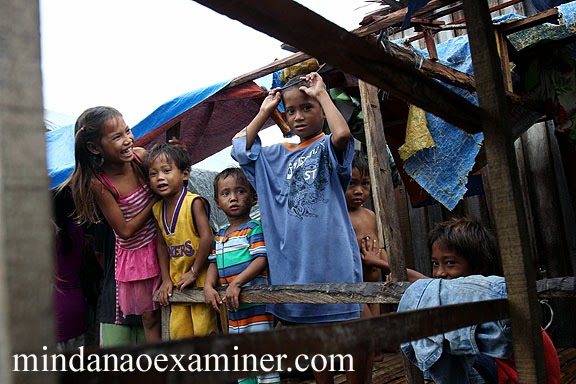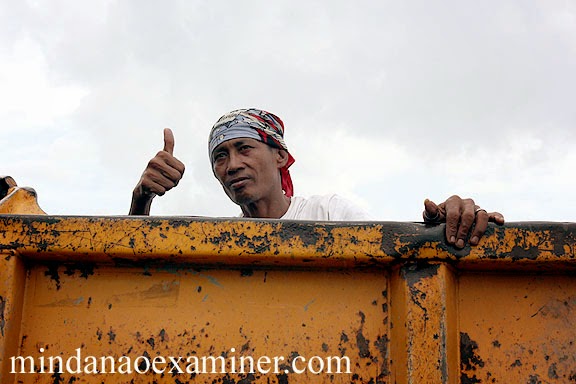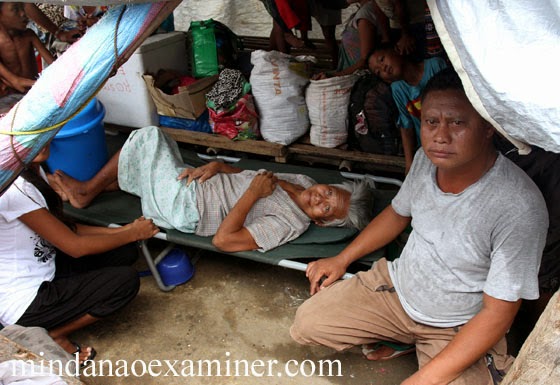
A policeman stands guard as a government truck hauls war refugees and transfer them to a government school converted into temporary shelter in Zamboanga City on Friday, April 11, 2014 and . Thousands ofwar refugees are still languishing in filthy evacuation centers since September 2013 following attacks by Moro National Liberation Front rebels. (Mindanao Examiner Photo)
ZAMBOANGA CITY (Mindanao Examiner / Apr. 11, 2014) – Dozens of war refugees staying in tents and filthy evacuation site have been transferred to a government school on Friday, but many also vowed to fight the planned government relocation saying they wanted to return to their villages to rebuild their lives.
Musa Bulahaw, one of the refugee leaders and member of the indigenous Badjao tribe, said it would be difficult for them to relocate to temporary bunk houses in the villages of Mampang or Tulungatung and even in Taluksangay because fishing is their sole means of livelihood.
“If they relocate us in those areas, our livelihood would be greatly affected and our families, our people will go hungry because fishing is the only livelihood we know. We live by the sea, we are Badjao and we belong to the sea,” he told reporters.
Bulahaw said his 65-year old mother Kim has suffered a stroke and cannot walk and now lives with them in the tent along coastal Roseller Lim Boulevard. “Look at her, she cannot walk, she is now paralyzed and the poor condition we are in makes it more difficult for her to live and we have been appealing repeatedly to the government to send us back home in our villages,” he said. “If they use force to evict us, then blood shall be in their hands if anything bad happens here.”
Government trucks hauled about 100 refugees to Mampang village where at least 23 school rooms have been converted into temporary shelters. Each room can accommodate at least 2 families or about 15-20 people. Villagers and teachers have protested the relocation of the refugees in the school, but the local government said it has the approval of the Department of Education and refugees will stay there until new bunk houses are built for them far away from their original habitat.
Police closed the stretch of the boulevard and guarded the hauling of refugees. Some of the refugees favored their relocation and thanked the local government for assisting and transporting them to Mampang and other transitory sites, but they also asked for livelihood skills training after learning that the government has provided other refugees with short-term training on food processing, among others.
The United Nations has expressed alarm over the poor conditions of tens of thousands of war refugees still at different filthy evacuation centers and transition sites here. More than 100 refugees had died from diseases in the evacuation centers and the number is increasing due to lack of sufficient medical and emergency facilities there.
Those in the evacuation areas were villagers affected and displaced by rebel attacks mounted in September by the Moro National Liberation Front under Nur Misuari. The attack sparked three weeks of street battles that killed and wounded over 400 people and displaced some 120,000 villagers.
“There is an urgent need to find shelter solutions for these IDPs,” said Jens Laerke, spokesperson for the Office for the Coordination for Humanitarian Affairs, at a press briefing in Geneva, referring to internally displaced persons.
Citing current figures from the Department of Social Welfare and Development, Laerke said that the refugees currently lack access to adequate and safe water and sanitation and there are serious health concerns – acute respiratory infections, diarrhoea and skin diseases – due to overcrowding in the two largest evacuation centers hosting some 20,000 refugees, including the Joaquin Enriquez Memorial Sports Complex.
“There is, for example, a need for 940 extra latrines to meet global standards. There is also a water shortage because of rationing imposed last month as reservoirs were low in the dry season,” he said, adding general food distribution to the affected people ended in December 2013.
Just recently, hundreds of Muslims protested the government’s failure to facilitate the return of refugees to their original villages. The refugees, many of them Tausug from Sulu; Yakan, from Basilan; and indigenous Badjao tribe from Tawi-Tawi province – engaged in fishing and other traditional livelihoods – were being relocated to the far-flung villages of Tulungatung and Taluksangay from their original habitat in the coastal villages of Rio Hondo and Mariki and other areas.
The government has built bunkhouses as temporary shelters to those affected by the violence, but it also warned that villagers who are not natives of Zamboanga would not be allowed to return to their former abode, unless they can provide certificates to show they are landowners.
Gammar Hassan, also a refugee leader, said refugees had died from diseases the past months in evacuations sites due to poor health services and malnutrition and lack medical and emergency facilities there. He said the government has prevented them from returning to their villages and has forced the refugees to relocation sites far away.
He said majority of the refugees have opposed the government’s relocation plan to put them in other areas saying it would be extremely difficult for them to rebuild their lives. He also urged the local government to allow the refugees to return to their places instead of holding them in evacuation centers. “Build back better till we all die in pain. Who will enjoy the promised development and rehabilitation? Send us home now, not tomorrow,” Hassan said. (Mindanao Examiner)

